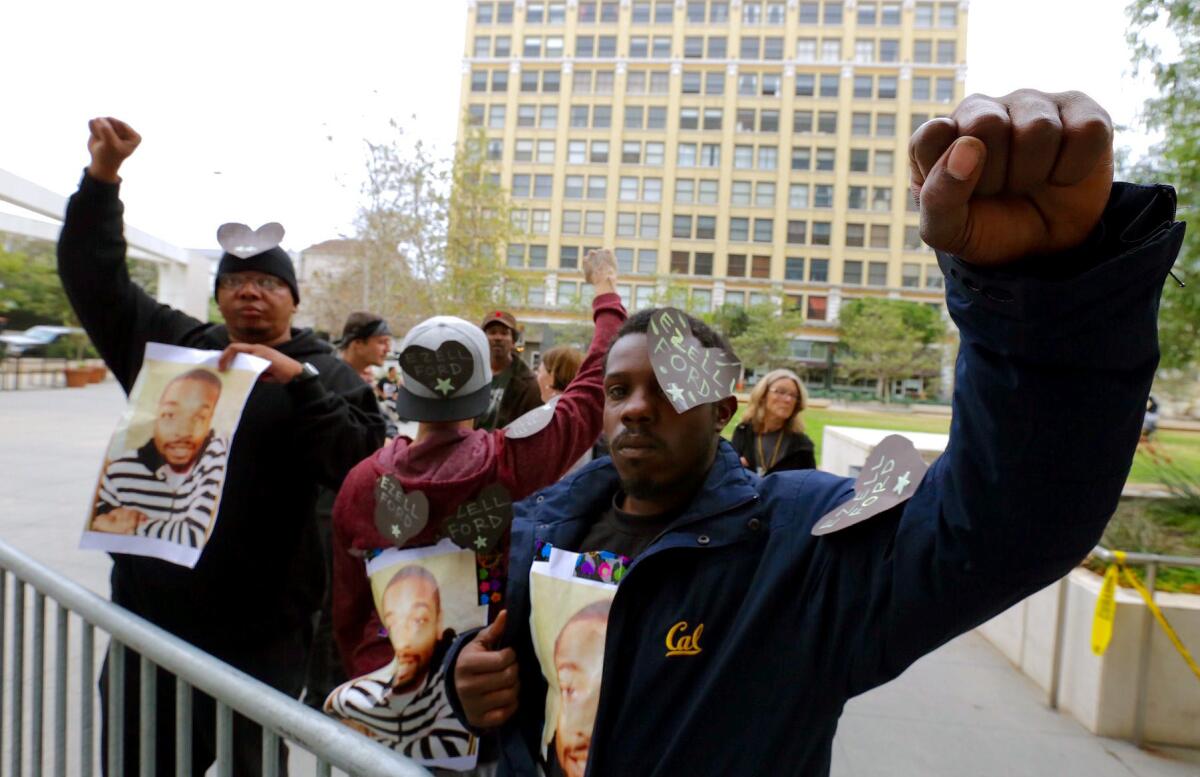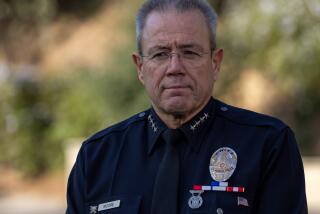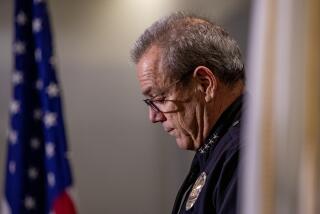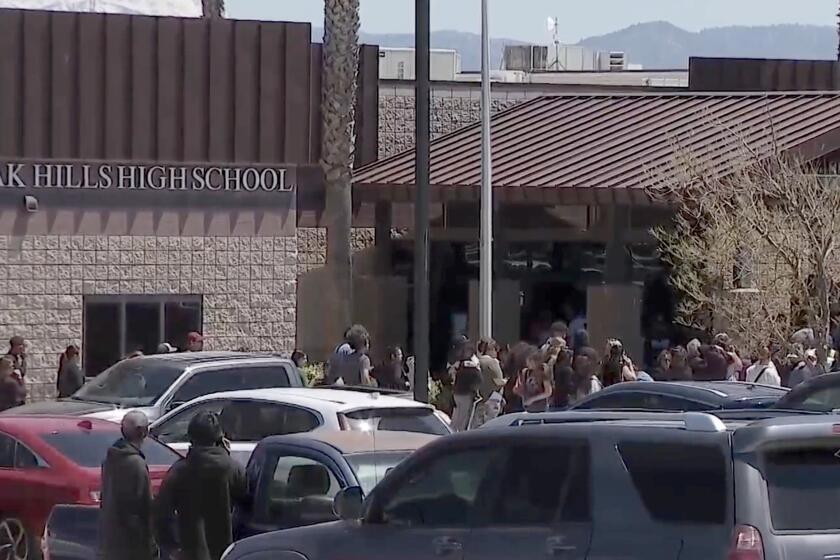L.A. Police Commission faults officers in Ezell Ford shooting

Theodore Moody, right, joins protesters outside LAPD headquarters Tuesday morning where the civilian board that oversees the Los Angeles Police Department later ruled on whether two officers violated department policy when they shot and killed Ezell Ford last summer in South L.A.
The Los Angeles Police Commission issued a mixed ruling Tuesday in last year’s killing of a mentally ill black man, finding that one officer was wrong to use deadly force but clearing another in the fatal shooting.
The board also faulted both officers for their decisions to draw their weapons at different points during the confrontation with Ezell Ford and disapproved of the tactics used by one of the officers.
The unanimous ruling brought to a close a 10-month investigation into a case that fanned anger and ignited protests over the use of deadly force by police.
Ford’s death became a local touchstone in a year when a string of controversial killings of black men by police around the country spurred a national debate about race and policing. Ford, who had been diagnosed with bipolar disorder and schizophrenia, died two days after the fatal police shooting of Michael Brown in Ferguson, Mo., which set off the outcry.
With their vote, the commission rejected a recommendation by LAPD Chief Charlie Beck, who believed both officers were right to open fire and had urged commissioners to clear both of any wrongdoing.
Like Beck, the commission’s inspector general also recommended that the panel find that the shooting was justified because of evidence pointing to a struggle between one of the officers and Ford over the officer’s gun.
As in all police shootings, the commission judged the two officers, Sharlton Wampler and Antonio Villegas, on three issues: the officers’ use of deadly force, their decision to draw their weapons and the tactics they used throughout the encounter.
While the commission identified the officers only by their ranks in announcing its decision, LAPD records show that it was Wampler, a 13-year veteran of the force, who was judged harshly. The commission found he was unjustified to open fire on Ford in the Aug. 11 shooting, wrong to draw his weapon, and had used unacceptable tactics.
Villegas, Wampler’s partner that night in an anti-gang unit, was found far less culpable. The panel disapproved only of his initial decision to draw his weapon early on in the confrontation, but said he ultimately was right to fire his weapon.
It appeared the commission’s decision to treat the officers differently hinged on the more aggressive role Wampler took in the encounter. Wampler approached Ford and physically attempted to restrain him, prompting a struggle that led the officers to shoot Ford, according to sources familiar with the investigation.
The five-member commission deliberated behind closed doors for several hours before emerging to announce their decision. In an emotional, rowdy public meeting that ran for nearly three hours Tuesday morning, commissioners listened as dozens of people called on them to hold the officers accountable for Ford’s death.
Once the decision was announced, the crowd in the commission’s meeting room responded by shouting, “murder!” As commissioners filed out of the room, some in the crowd pushed forward, demanding to know what the decision meant for the officers and what punishment they might face.
“What’s the next step?” one person asked.
“The next step is [Dist. Atty.] Jackie Lacey,” another member of the crowd said, referring to the county’s top prosecutor, whose office is reviewing the shooting.
The meeting had been punctuated earlier in the day by disruptions that at one point prompted the entire panel to abruptly walk out as audience members demanded more time to speak about the shooting.
A line of police officers moved to the front of the room. Angry demonstrators stood on chairs, chanting, “Shame on you, shame on you,” to the officers. One man was arrested on suspicion of disturbing the peace, an LAPD spokesman said.
Attorney Gary Fullerton, whose firm is representing the two officers, said he was pleased that one was cleared but “greatly disappointed” that the commission went against the recommendations of its inspector general, the police chief and the LAPD’s use of force board.
Fullerton defended the officers, saying that the evidence in the case showed they acted reasonably, and that he believed the commission acted as a result of public pressure.
“What we’re concerned about is the commission succumbed to the pressure of the mob,” he said. “It’s a shame that police officers can’t do their job and protect their lives.”
“They got in a fight with this guy and a bad thing happened,” he said. “It’s unfortunate that it happened.”
It now falls to Beck, who alone is authorized to discipline officers, to decide what punishment, if any, to impose.
In past shooting cases in which the commission went against Beck’s recommendation, the chief has angered the board by refusing to hand down discipline or giving only written admonishments. The chief can choose from a range of options that includes ordering the officers to be retrained, suspensions or moving to fire the officers.
Under a state law that gives police officers sweeping privacy rights, Beck’s decision on how to deal with the officers will not be made public.
Since the Aug. 11 shooting, Beck and other LAPD officials have not publicly explained why Wampler and Villegas chose to confront Ford as he walked at night on the sidewalk of a South L.A. street near his home.
Sources familiar with the investigation told The Times that the officers claimed they grew suspicious that Ford was in possession of drugs and was trying to discard them to avoid arrest. In his report to the commission, Beck wrote that the officers’ suspicions were based on having seen Ford walking away from a group of people and toward an alley known for drug use, the sources said.
However, the inspector general, Alex Bustamante, offered a significantly different account in a separate report, the sources said. Bustamante emphasized that the officers acknowledged to investigators they never witnessed Ford interact with the group and that he was 20 or 30 feet away from them when the officers first saw him, according to the sources.
No drugs were found on or near Ford, the sources said.
Upon catching up to him on the sidewalk, Wampler grabbed Ford, the sources said, citing the two reports. LAPD officials have publicly said Ford forced the officer to the ground and grabbed his gun, prompting both officers to open fire.
LAPD investigators found evidence supporting the account, including Ford’s DNA on the weapon and scratches on the hands of the officer and Ford as well as the gun’s holster, two sources said.
In his report to the commission, Bustamante was critical of Wampler’s attempt to physically restrain Ford, concluding the move fell far outside the scope of how LAPD officers are trained to handle such situations, sources said. Because a person could be armed, officers are taught instead to call out commands to a person from a place of safety, such as behind their open car door.
Ford was one of 18 people killed and nine others wounded in LAPD shootings last year, the department said. As of June 1, police officers had shot and killed eight people and wounded another eight this year, the department said.
For more news, follow @katemather and @joelrubin.
More to Read
Start your day right
Sign up for Essential California for news, features and recommendations from the L.A. Times and beyond in your inbox six days a week.
You may occasionally receive promotional content from the Los Angeles Times.








